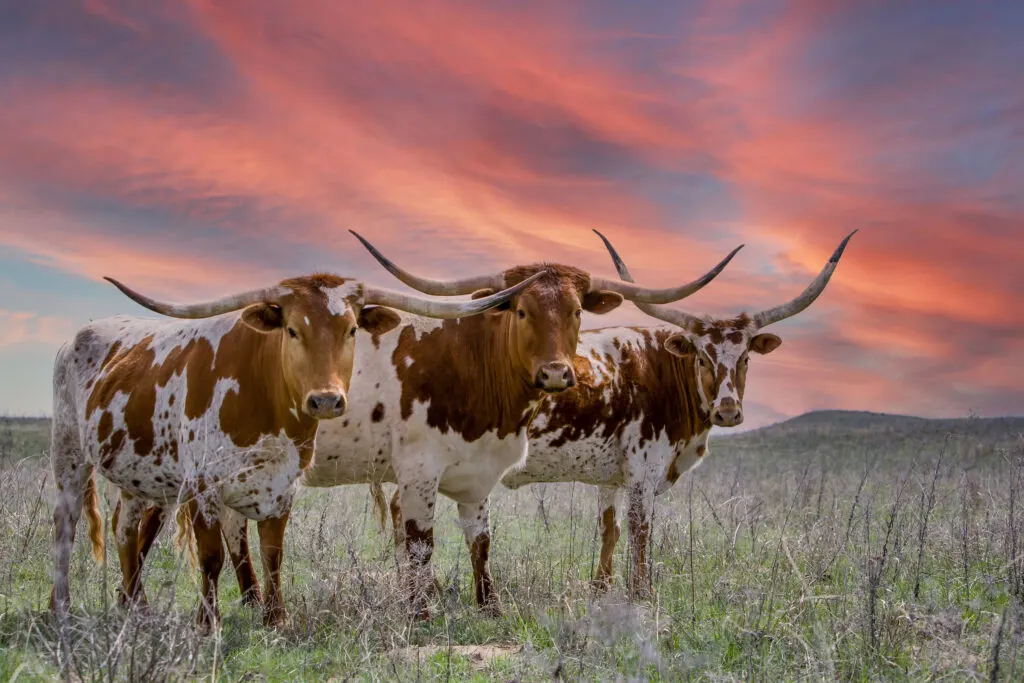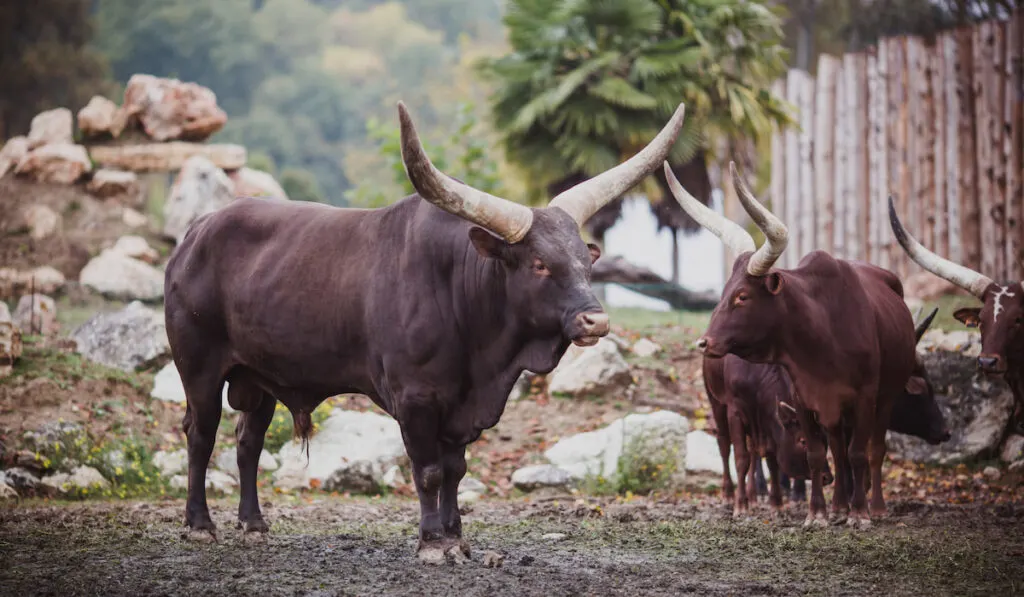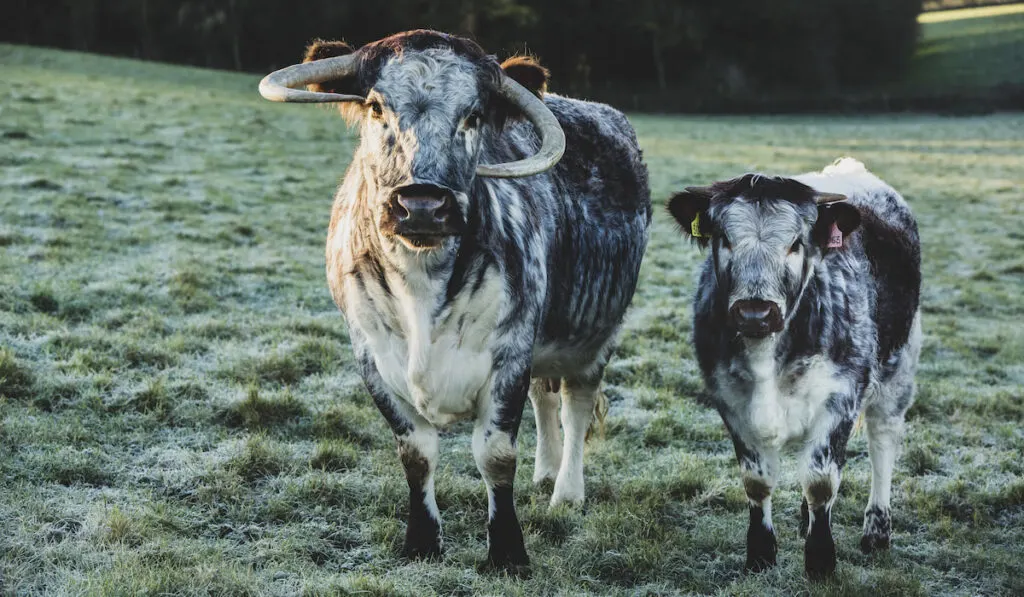A lot of cattle breeds have horns, but long-horned cattle breeds are a sight to behold. They look incredible and are some of the world’s most famous cows and bulls. One great example is the Texas Longhorn, which is the state public university’s mascot and has made appearances in all sorts of movies.
Introducing a long-horned cattle breed into your herd offers more diversity. While the horns look intimidating, most long-horned cattle breeds are calm and gentle animals you’ll love for years. While there aren’t that many long-horned cattle breeds, they’re not that difficult to get in the United States.
Here’s some good information on cattle breeds with long horns and what you need to know if you’re looking to get one for your farm or homestead. Knowing the different characteristics of each breed will help you choose the best breed and prepare your place before it arrives.
Table of Contents
The Texas Longhorn

The Texas Longhorn is the most famous of all the longhorn cattle breeds. When Spanish conquistadores arrived on Christopher Columbus’ second voyage to the Americas, they brought cattle as a food source.
They made their way up through Mexico and eventually found their way into what is now Texas. Some of the cattle either escaped or were let free and became feral. For generations, these animals developed the ability to withstand drought conditions and adapt to different climates.
Later, settlers in Texas rounded up these Mexican cattle and bred them with cows they already had. The result was the Texas Longhorn we know and love today.
These cows typically come in shades of red, white, and yellow, with spots across their bodies. There are also some Longhorns with blue, brown, and cream coats.
What two breeds make a Texas Longhorn? The Spanish Retino mixed with English cattle to make this uniquely American cattle breed.
The Texas Longhorn is famous for its beautiful horns that can grow up to seven feet long. They have lean beef and gain weight quickly, which has made them a popular choice for farmers. Certain premium bloodlines can fetch as much as $40,000 per steer at auction.
In 1995, Texas made the Longhorn its state animal, and it’s now a state cultural symbol. Respect for these cattle goes back to earlier times when settlers needed a hardy animal that could survive rough conditions to keep the first settlers in Texas alive.
Ankole-Watusi

Ankole-Watusi cattle hail from countries like Uganda, Rwanda, and other parts of Western Africa. These large animals thrive in open forests and meadows, feeding primarily on grass and other vegetation. Their long horns evolved to defend them from predators like lions on the African plains.
Ankole cattle live more than 20 years, which is quite long for cattle. They typically cost more than most other breeds because they are larger, and farmers love their long, thick horns. They’re popular as meat-producing cattle and are found in almost every country with a thriving beef industry.
In Africa and other parts of the world, their horns are prized possessions, and some tribes consider the breed a holy animal. The horns can weigh up to 1,500 pounds alone.
Ankole-Watusi milk is approximately 10% fat, so some American dairy farmers mix these cows with other domestic cattle to increase the fat content in their milk for cheese, yogurt, and other high-fat dairy foods.
The English Longhorn

English Longhorns are another popular long-horned cattle breed. Despite the name, they aren’t related to the Texas Longhorn. Originally from northern England, this animal was famous for its milk production in butter, cheese, and other staples.
After slaughter, farmers sold their horns to make cups, lamps, buttons, combs, and other household items. Some people even used thin slices of the horns as a glass replacement when glass was more expensive.
In contrast to the prior two breeds, the English Longhorn’s horns usually grow down and around their heads, making them a vicious weapon against any would-be predators. They have lean meat and farmers love them because they produce and pass calves quickly.
While the look of the horns makes them a bit intimidating, they’re quite docile and gentle creatures. They’re easy to manage and love to graze, saving farmers money on costly feed.
They come in a mix of red, white, and grey. Males can reach up to 2,000 pounds, while cows are typically much smaller.
Scottish Highland Cattle

Highland cattle originated in the highlands of Scotland. They have long horns and a unique shaggy coat, making them very popular as pets and farm animals.
They’re powerful animals that can withstand cold temperatures and high winds. Highland cattle are best known for their long horns that grow outward, curving toward the sky, and their trademark shaggy hair that falls over their eyes.
The coat is usually red or brown, but some cattle are yellow, black, or white. They have a double coat of hair that protects them from the cold and makes them look more like a pet than a farm animal. Breeders breed Highland cattle to become smaller to make them easier for families and homesteaders to own them.
Traditionally, Highland cattle were bred for meat. Their beef is leaner than some other breeds because their hair keeps them warm, while layers of fat provide warmth for other breeds of cattle. They also survive on harsher lands than other cattle, producing good beef relative to what they eat.
You can find this breed in the U.K., U.S., Australia, Canada, Finland, and Denmark. It’s a fantastic breed for colder climates and pastures with limited grass.
Geltex Cattle
The Geltex cattle breed was created decades ago to mix the Texas Longhorn’s hardiness with a breed with better beef quality. The Texas Longhorn is a fantastic breed because it can survive in harsh conditions, but it doesn’t have the best beef in the world.
However, mixing the Longhorn with larger, premium beef Gelbvieh cattle produces the Geltex breed that helps farmers grow delicious products faster. And they still get the lovely, long horns that people love from Texas Longhorns.
Breeding programs are an effective way to develop new breeds with positive character traits. So, Geltex gets the strength and high fertility rates of the Texas Longhorn and the size of the Gelbvieh.
Look for more longhorn breeds to pop up in the future as scientists develop ways to make better cattle faster.

What Breeds of Cattle Have Long Horns?
Length is relative. There’s no definite length that makes one breed a longhorn and another a shorthorn. While many breeds have bulls with horns, the five breeds on this list are some of the world’s most notable longhorn cattle. Their incredible horns make them prized animals in many countries.
Even though we no longer use horns to make glass or cups, you can still find people making products with horns today. For example, African jewelers use Ankole-Watusi horns to make bracelets, earrings, and necklaces. Sustainable farmers are always looking for ways to use horns in today’s economy.
Longhorn cattle breeds often come from areas with harsh weather conditions, numerous predators, and other threats. They used their horns to protect themselves against dangers. The horns are also an essential part of the mating ritual.
Resources
- https://en.wikipedia.org/wiki/Texas_Longhorn
- https://afs.okstate.edu/breeds/cattle/ankolewatusi/index.html/
- https://www.thecattlesite.com/breeds/beef/61/english-longhorn/
- https://en.wikipedia.org/wiki/Highland_cattle
- https://www.treehugger.com/not-your-average-cow-most-exceptional-cattle-breeds-4864093
- https://petkeen.com/types-of-longhorn-cattle-breeds/
